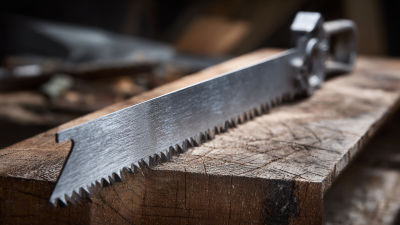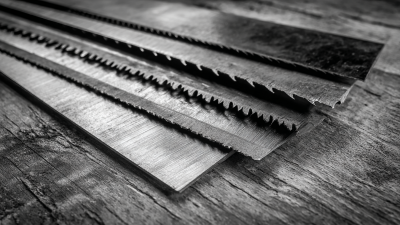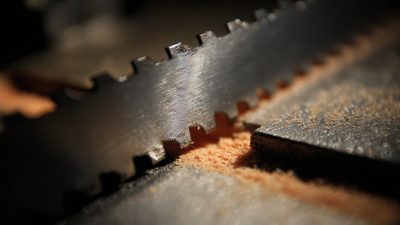Top 10 Hacksaw Blade Types: A Comprehensive Guide to Choosing the Right Blade for Your Projects
Table of Contents
- Understanding Hacksaw Blade Types: Key Features and Benefits
- The Importance of Material Selection for Hacksaw Blades
- Choosing the Right Tooth Count for Your Cutting Needs
- High Carbon vs. Bi-Metal Blades: Which is Best for You?
- Specialty Hacksaw Blades: Applications and Advantages
- Tips for Maintaining and Extending the Life of Your Hacksaw Blades
- Optimizing Cutting Efficiency: Insights from Industry Reports on EC32T-12IN BI-METAL Hacksaw Blade Performance and Applications
- FAQS
- Conclusion
- Related Posts
When it comes to cutting tools, choosing the right hacksaw blade can really make a difference in how smoothly your project goes and the final outcome. I recently came across a report from Market Research Future that says the global power tools market — including electric tool accessories — is expected to grow steadily at about 5.4% annually from 2021 to 2026. That tells us people are on the lookout for better, more precise tools, whether they’re professionals or just DIY weekend warriors. Performance and accuracy are more important than ever.

Hacksaw blades actually come in a bunch of different types and materials, each suited for specific tasks—whether you're working with metal, wood, or plastic. Honestly, choosing the right one can sometimes feel overwhelming with so many options out there. Getting to know the top hacksaw blade types can help you get better results, cut down on downtime, and just make your project flow more easily.
Here at Wenzhou Yichuan Tools Co., Ltd., we totally get how important it is to offer products that match what users actually need. Since we started back in 2003, we've been focused on crafting high-quality jigsaw blades, reciprocating saw blades, and planers. Over the years, that’s helped us build trust with both pros and hobbyists who count on us for reliable tools to get the job done. In this guide, I’ll walk you through the top five hacksaw blade types so you can make smarter choices tailored to your specific cutting needs.
Understanding Hacksaw Blade Types: Key Features and Benefits
When it comes to selecting the right hacksaw blade for your projects, understanding the key features and benefits of various blade types is essential. Hacksaw blades are typically classified by their TPI (teeth per inch), material composition, and design. A higher TPI is ideal for cutting thin materials such as sheet metal or plastic, providing a smoother finish and reducing the risk of tearing. Conversely, blades with a lower TPI are better suited for thicker materials, allowing for quicker cuts but potentially rougher edges.
Moreover, different materials used for hacksaw blades also significantly impact performance. Bi-metal blades, for instance, combine flexibility and durability, making them versatile for cutting a wide range of materials from metal to wood. Carbon steel blades, while less expensive, may dull quickly but are suitable for lighter tasks. Understanding these attributes allows users to make informed decisions based on the specific requirements of their projects, ensuring efficiency and precision in their cutting tasks.
Top 10 Hacksaw Blade Types: Comparison of Key Features
This chart displays the durability ratings of various types of hacksaw blades. A higher rating indicates better durability, which is crucial for different cutting applications in your projects. Choose the right blade based on its durability to ensure optimal performance.
The Importance of Material Selection for Hacksaw Blades
When choosing a hacksaw blade, material selection is a crucial factor that can significantly impact performance and cutting efficiency. Hacksaw blades are typically made from various materials, including high-carbon steel, bi-metal, and high-speed steel, each offering distinct advantages based on the specific application. High-carbon steel blades are ideal for general-purpose cutting and are often cost-effective, but they may dull quicker when used on harder metals. On the other hand, bi-metal blades combine flexibility with durability, making them suitable for cutting a wider range of materials, including harder metals.
Understanding the importance of material selection allows users to match the hacksaw blade to their project's needs effectively. For example, if you are cutting through tougher materials like stainless steel or hardened rebar, opting for a bi-metal or high-speed steel blade is advisable due to their superior longevity and cutting capacity. By considering the material of both the blade and the workpiece, you can enhance efficiency and achieve clean, precise cuts in various projects, ensuring that your hacksaw operates at its best no matter the challenge.
Choosing the Right Tooth Count for Your Cutting Needs
When choosing the right hacksaw blade, the tooth count plays a pivotal role in determining your cutting efficiency and the quality of results. Generally, blades with fewer teeth per inch (TPI) are designed for cutting softer materials, as they remove material more quickly but produce a rougher finish. On the other hand, blades with a higher TPI are ideal for harder materials or for achieving cleaner cuts. Therefore, assessing the specific requirements of your project is crucial in selecting the appropriate tooth count.

High Carbon vs. Bi-Metal Blades: Which is Best for You?
When selecting a hacksaw blade, understanding the differences between high carbon steel and bi-metal blades can significantly impact the success of your projects. High carbon blades are often more affordable and suitable for cutting softer materials like plastic and wood. However, they tend to dull quicker when tackling tougher materials. On the other hand, bi-metal blades combine high-speed steel teeth with a flexible backing, enhancing durability and cutting efficiency. This makes them ideal for a broader range of applications including cutting through metals like stainless steel and hardened steel, ultimately leading to a better long-term investment.

Tips: When choosing a blade, consider the specific materials you’ll be working with. If your projects involve frequent cutting of tougher materials, opt for bi-metal blades for their longevity and performance. Additionally, ensure that the blade's teeth per inch (TPI) aligns with the material density; a higher TPI is better for thinner materials, while a lower TPI is advantageous for thicker materials. Always keep an eye on blade wear and replace them promptly to maintain cutting efficiency.
Specialty Hacksaw Blades: Applications and Advantages
When selecting a hacksaw blade, understanding the various specialty blades available can significantly enhance your project's efficiency and precision. Specialty hacksaw blades are designed to handle specific materials, ensuring optimal performance in diverse cutting applications. For instance, bi-metal blades combine high-speed steel teeth with a flexible backing, making them ideal for cutting through tough metals like stainless steel and aluminum. This combination allows the blade to maintain sharpness while being resilient enough to withstand the stresses of harder materials.
Another noteworthy option is the carbide-tipped hacksaw blade, which excels in cutting hard materials such as tile, stone, and some composite materials. These blades offer superior longevity compared to standard blades, reducing the need for frequent replacements during projects. Additionally, blades designed specifically for plastic cutting feature fine tooth patterns that prevent chipping and ensure a clean edge.
Choosing the right specialty blade not only improves the quality of the cut but also enhances safety and efficiency, making it essential to match the blade type to your specific project's needs.
Tips for Maintaining and Extending the Life of Your Hacksaw Blades
To ensure optimal performance and longevity of your hacksaw blades, proper maintenance is essential. According to industry data, nearly 30% of hacksaw blades fail prematurely due to neglect in maintenance. A simple yet effective practice is to regularly clean the blade after use. Removing debris and material buildup helps preserve the cutting edge and prevents rust formation. Using a soft brush or cloth can effectively remove sawdust and metal shavings.
Another critical aspect of extending the life of your hacksaw blades is proper storage. Storing blades in a dry, dust-free environment can significantly reduce the risk of corrosion. A report by the Metalworking Business Indicator suggests that 25% of blade deterioration can be attributed to improper storage conditions. Additionally, when changing blades, always ensure they are correctly tensioned. An adequately tensioned blade reduces wear and ensures cleaner cuts, thus minimizing the need for frequent replacements. By incorporating these maintenance tips, users can maximize the lifespan and efficiency of their hacksaw blades, ultimately leading to cost savings and improved project outcomes.
Optimizing Cutting Efficiency: Insights from Industry Reports on EC32T-12IN BI-METAL Hacksaw Blade Performance and Applications
The performance of tools is crucial to achieving optimal cutting efficiency in various industrial applications. One of the standout products in this domain is the EC32T-12IN BI-METAL Hacksaw Blade, which has been favored in multiple industry reports for its durability and precision. This blade's design combines high-speed steel with a flexible backing, making it exceptionally adept at slicing through various materials, particularly metal, while maintaining a fine, clean edge.
When it comes to applications, the EC32T hacksaw blade excels not only in metal cutting but also provides versatility in handling different types of projects. For instance, it is an ideal choice for professionals working in metal fabrication, plumbing, and construction, where efficiency and accuracy are paramount. The innovative bi-metal construction allows the saw blade to withstand significant stress, offering longevity comparable to that of more expensive specialized tools. Ultimately, employing the EC32T-12IN BI-METAL Hacksaw Blade translates to reduced material waste and increased operational efficacy in tough cutting scenarios.
FAQS
: You should consider the teeth per inch (TPI), material composition, and the specific materials you will be cutting. Higher TPI is ideal for thin materials, while lower TPI works better for thicker ones.
High carbon blades are cost-effective and suitable for softer materials but dull faster on tougher materials. Bi-metal blades, combining high-speed steel with a flexible backing, offer enhanced durability and are better for a broader range of materials, including hard metals.
Material selection is crucial because it impacts the blade's performance and cutting efficiency. Different materials suit different applications, enabling users to match the blade to their project's needs effectively.
Choose a bi-metal blade if you frequently cut tougher materials like stainless steel or hardened rebar, as they provide superior longevity and cutting capacity compared to high carbon blades.
Using a blade with the incorrect TPI can lead to poor cutting performance. A higher TPI provides smoother cuts for thinner materials, while a lower TPI can more efficiently cut thicker materials but may result in rougher edges.
To enhance cutting efficiency, match the blade's material and TPI to the material density you are cutting, ensure regular blade replacements, and utilize the appropriate blade type for your specific cutting tasks.
Conclusion
When it comes to selecting the right hacksaw blade types for your projects, understanding their key features and benefits is essential. This comprehensive guide covers everything from the importance of material selection to the appropriate tooth count based on your cutting needs. The comparison between high carbon and bi-metal blades helps users determine which option suits their tasks best, while specialty hacksaw blades highlight specific applications and their advantages. For professionals and DIY enthusiasts, maintaining and extending the life of hacksaw blades is crucial for optimal performance.
At Wenzhou Yichuan Tools Co., Ltd., we understand the diverse needs of our customers, which is why we focus on producing high-quality tools, including various hacksaw blade types. Established in 2003, our expertise ensures that both professionals and hobbyists can find reliable and durable blades to enhance their projects.
Related Posts
-

7 Best Hacksaw Blades for PVC You Need to Know
-

How to Choose the Right Hacksaw Blades for Optimal Cutting Performance in Toolstation Projects
-

Unmatched Quality Hacksaw Blades: Crafted in China for a Global Market
-

Navigating the 2025 Landscape: Innovations in Best Hacksaw Blade Double Sided Technology
-

7 Best High Speed Hacksaw Blades for Efficient Cutting
-

Understanding the Common Challenges with 12 Inch Hacksaw Blades in Global Supply Chains






